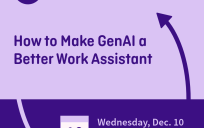![]()
The Census Bureau has been undergoing a digital transformation to allow Americans to more easily access the wealth of statistics that we collect from households and businesses each year. (I talked about digital access in my last post.) We have been restructuring our website and online presence, presenting our data in new, easier-to-use ways, and making sure that all our users get an enhanced Census Bureau digital experience.
We’re about four years into that five-year plan, which aligns with the President’s call for federal agencies to create a more 21st century digital presence. Even iterative, small changes here and there have been in service of that longer-term vision.
The Census Bureau was among the first federal agencies to launch its website in March 1994. Over the years, our user interface to content from hundreds of surveys grew cumbersome and hard to navigate. Our customer research uncovered that our expert users — who include economists, researchers, and demographers — were consistently delving into our goldmine of information. However, the way the data was presented, usually in complex charts and tables, was difficult to read for non-experts, especially when a search engine just plunked them somewhere on the site.
Now, those complexities are falling by the wayside as we adopt user-centered navigation, customizable apps, and visualizations, among other more modern means of providing data. For any organization, big or small, we have three important lessons to share to help you navigate your own digital transformation. They tackle the intricacies of setting everyone on a common course, building collaboration, and managing expectations.
Lesson 1: Understand Your Users’ Needs
When we embarked on our digital transformation, it was in response to our customers. We knew about one-third of our audience consisted of expert data users who easily spent hours milling through our online tables and statistics. But our analytics revealed that the other two-thirds of our web traffic belonged to first-time users or casual visitors who just wanted to find a number or two to answer a basic question.
So we studied how users were interacting with the site and the data to gain a better understanding of their needs — like the types of tools they wanted or what kind of information they sought to access. After analyzing the results of those studies and user input, we surfaced high priority changes, including:
- Topic-focused navigation, instead of the organization-focused navigation we used to have.
- Better search functionality to provide immediate answers and more relevant organic results.
- Easily shared data, which allows users to intuitively share Census Bureau information to their websites and social media circles.
- Opportunities to provide additional relevant information and data.
Our best advice is for you to fully understand what your users need before you implement change and use rich analytics to help you reveal what users are really doing. If you’re giving people what they want, they’re more likely to accept your website or content changes and they’ll want to come along with you for the ride.
Lesson 2: Build a Multi-Level Integrated Team
We started to overhaul our digital presence with a small core team. As expected, the depth of the project grew as we moved through the process. So we did what made sense.
We added team members. Strategically.
We pulled people from different departments across the Census Bureau, especially those who dealt with the public frequently, to broaden the team’s perspective. Having a multi-level integrated team with many voices enhanced how we thought about our place in the digital world, and how we would brainstorm, collaborate, and continue to serve the American public. That fed the development of our five-year transformation plan.
The growing team ensured we were all invested in the project and had a sense of ownership in the process to transform Census.gov. We weren’t just working in separate departments of a massive machine. We were working together, sharing ideas, and achieving a common vision driven by internal and external customer needs.
Lesson 3: Establish Quick Wins
Five years is a long time. It’s easy to lose momentum and forget what and whom you’re working for, especially if movement takes a while. We learned that lesson quickly; we actually saw enthusiasm for the new and improved site slow within weeks of the announcement of the five-year plan.
Our team quickly went to work on our website to breathe new life into the customer experience. We started by:
- Simplifying navigation and the home page based on initial research.
- Releasing simple data tools and widgets to enhance existing ones.
- Adding more visual content for first-time users.
These small steps forward were enough to give everyone the iterative energy boosts needed to keep the motivation going as we tackled larger projects to develop new apps and construct a totally new content model and customer experience.
The need to perfect a system can sometimes overshadow good intentions and reduce a big change to a never-ending waiting game. After all, we are all agents of change — it just takes some understanding, collaboration, and small victories to see that change through.
Stephen L. Buckner is part of the GovLoop Featured Blogger program, where we feature blog posts by government voices from all across the country (and world!). To see more Featured Blogger posts, click here.





As someone who has been training data users from local governments, Congressional offices, non profit agencies, school districts and small business organizations, I have witnessed the transformation firsthand. I hear more of …this website has become more user-friendly …People are feeling more empowered to use Census Data to make their case, tell their community’s story and include data for business plans and grants. Let’s keep going!
Pauline, you do an amazing job working out there with the local data users! Thank you for sharing – this is great to hear. Empowering our customers is such a critical part of the digital transformation.
Thank you for sharing how small changes can make a big difference!
Thank you for taking the time to join the conversation, Sonia.